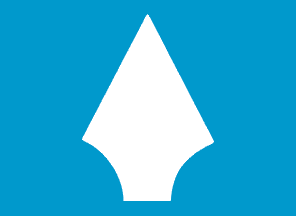 by Jan Oskar Engene, 27 April 2002
by Jan Oskar Engene, 27 April 2002Approved on 9 July 1976.

Last modified: 2005-02-12 by phil nelson
Keywords: alta | spearhead |
Links: FOTW homepage |
search |
disclaimer and copyright |
write us |
mirrors
 by Jan Oskar Engene, 27 April 2002
by Jan Oskar Engene, 27 April 2002
Approved on 9 July 1976.
See also:
Like many Norwegian municipalities, Alta looked back into history to find a suitable coat of arms. There is a tendency to favour charges that can be constructed as "Viking" in some way. In the case of Alta, there was opportunity to go even further back into history, into the Stone Age to uncover a suitable charge. The result of this "heraldic-archaeological expedition" was to use as a charge an spearhead of the type employed by the people of the Komsa Culture, a stone age culture that thrived in the area around Alta and which used spearheads made from quartzite. Alta is also known for its slate industry, making for instance tiles for roofing, and for copper mining. The spearhead may then also be interpreted as a drill used in these industries. As for the colour symbolism, silver/white stands for Alta's main natural resources, slate and fish, while blue stands for the sea, the river and the mountain plateau. This according to [cjo87].
Jan Oskar Engene, 27 April 2002
I read somewhere, probably in [cjo87], about the reasoning behind showing the pre-heraldic charges in the modern COAs (and flags). As we all well aware, the Norwegian modern municipal heraldry has very strict rules, returning to the roots of heraldry. Therefore, the charges representing real things (i.e. non-geometrical shield division) has one of the rules that govern them approximatley set as "the charge should be of form as the object has been used in the early heraldic period". I.e. the heraldic charges avoid modern shapes